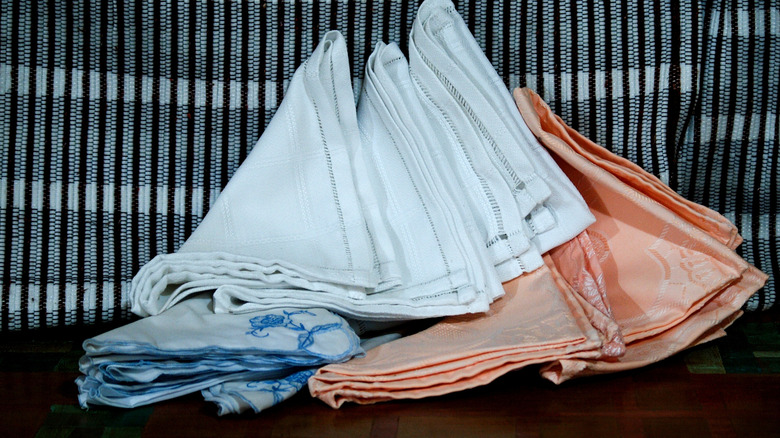The Easy Way To Brighten Any Room With Vintage Linens
Sometimes all it takes to inject a bit of charm into your space is a look to the past for inspiration. Whether it's vintage kitchen accessories that are making a sudden comeback or one-of-a-kind pieces of art, there are endless ways to incorporate vintage decor around your home. But, one of the trickiest items to style tends to be vintage linens and clothing. Short of throwing them on a bed or stashing them in a drawer, you might feel like there isn't much you can do with these practical pieces of history. They are often delicate, oddly shaped, or sentimental, meaning DIY projects have to maintain the integrity of the pieces. What if there was a way to show off their softness and personality without risking damage? Good news: There's a simple trick that turns vintage fabrics into beautiful, personalized wall decor and all it requires is the right frame.
Framing vintage linens is more than just a clever display idea — it's a way to celebrate the intricate details that make each item unique. A lace-trimmed handkerchief or an embroidered tea towel can instantly add warmth to your space, simultaneously acting as a focal point and a subtle nod to the past. Most importantly, the trick protects the fabric itself from everyday wear and tear, ensuring that it can be passed down for generations. The texture, detail, and gentle fading of an older piece of linen can be a personal touch on your walls, especially in places like bedrooms, hallways, or kitchens. It is a practical way to honor your treasured linens, breaking them out of the confines of study drawers or storage bins for their moment in the decorative spotlight.
How to frame vintage fabrics with preservation in mind
The first step in framing your vintage linens is to give them a gentle washing. If you aren't a fan of the yellowing on fabric that accompanies age, you can try to use a mixture of cold water and vinegar to remove them. This can also be an effective way to get in on the vintage home decor trend without the weird smells or cigarette staining. The yellow hue on certain fabrics can contribute to the warmth that is often associated with vintage linens, so you may want to skip the vinegar soak to preserve it as much as possible. Next, you'll want to use a mild detergent and cool water to soak your linens. Avoid using any bleach or harsh chemicals that may damage your fabric. Rinse any remaining detergent off the fabric before laying it out to dry.
Once you've successfully washed your vintage fabrics, it's time to start framing. It is important to determine whether you will be using a traditional frame or a shadowbox during this step. Smaller items like handkerchiefs, tea towels, or a repurposed vintage doily might fit inside traditional frames. However, larger vintage items might benefit from the extra space provided by a shadowbox. It allows you to fold your items so that the decorative elements are facing outwards. Lay your pieces of fabric inside the frame and ensure that the design is centered correctly. You may want to choose a mat that gives the fabric some breathing room from the glass, as it might look awkward on display. Reattach the back of the frame before choosing the best place to display your newly created artwork.
